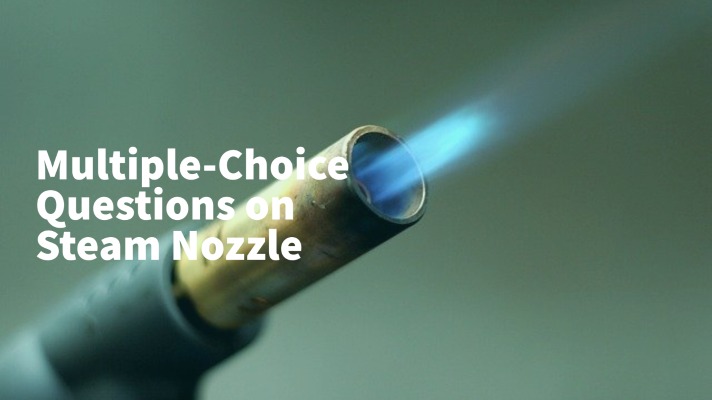In all the examinations, there must be multiple-choice questions. In this article, I will display some Multiple-Choice Questions on Steam Nozzle that will boost you in your coming examinations.
In the last section, there is a Quiz on Steam Nozzle. Appear for the test and fall in love with studying a lot of objective-type questions.
To download this MCQ sheet, you have to reach the end of this page. There you will find a PDF downloadable button. Click here and download the PDF version of this sheet.
So now let’s start the objective-type questions or viva questions on Steam Nozzle.

MCQ questions or Viva Questions on Steam Nozzle
- Heat energy of steam is converted into ______ energy in a steam nozzle.
- Potential energy
- Kinetice energy
- Electric energy
- None of these
Ans: (2)
- When the cross section of a nozzle decreases continuously from entrance to exit, it is called a ____.
- Convergent nozzle
- Divergent nozzle
- Convergent-divergent nozzle
- None of these
Ans: (1)
- When the cross section of a nozzle increases continuously from entrance to exit, it is called a ____.
- Convergent nozzle
- Divergent nozzle
- Convergent-divergent nozzle
- None of these
Ans: (2)
- When the cross section of a nozzle first decreases and then increases, it is called a ____.
- Convergent nozzle
- Divergent nozzle
- Convergent-divergent nozzle
- None of these
Ans: (3)
- The smallest section of the nozzle is known as ____.
- Convergent portion
- Divergent portion
- Throat
- Both (1) and (2)
Ans: (3)
- Steam enters the nozzle with ____ pressure and ____ velocity.
- Low,high
- Low,low
- High,high
- High,low
Ans: (4)
- Steam leaves the nozzle with ____ pressure and ____ velocity.
- Low,high
- Low,low
- High,high
- High,low
Ans: (1)
- The back pressure of nozzle is ____.
- The pressure at which steam enters the nozzle
- The pressure at throat
- The pressure at which steam leaves the nozzle
- None of these
Ans: (3)
- Nozzle efficiency is the ratio of ____.
- Isentropic heat drop and useful heat drop
- Useful heat drop and isentropic heat drop
- None of these
Ans: (2)
- How does the friction in a nozzle effects the dryness fraction of steam?
- It does not effect
- Friction decreases the dryness fraction
- Friction increases the dryness fraction
- None of these
Ans: (3)
- The exit velocity of steam in the nozzle (V) is ____(where k is nozzle coefficient and hd – enthalpy drop during expansion)
- 72.44(K-hd)
- 44.72 sqrt(Khd)
- 72.44(K+hd)
- 44.72 sqrt(K/hd)
Ans: (2)
- On which of the following parameters, the discharge in a convergant-divergant nozzle depends upon?
- The area of the nozzle at throat
- Initial conditions of the steam
- Exit conditions of the steam
- Both (1) and (2)
Ans: (4)
- When the steam is initially dry saturated, the critical pressure ratio is ____.
- 1.135
- 1.582
- 0.577
- 0.135
Ans: (3)
- When the steam is initially superheated, which value you will choose for the critical pressure ratio?
- 0.577
- 0.546
- 0.582
- 0.528
Ans: (2)
- For initially wet steam, which value will you choose for critical pressure ratio?
- 0.577
- 0.546
- 0.582
- 0.528
Ans: (3)
- For gases, which value will you choose for critical pressure ratio?
- 0.577
- 0.546
- 0.582
- 0.528
Ans: (4)
- For initially dry saturated steam, which is the right formula?
- Mmax= 0.637A sqrt(p1/v1)
- Mmax= 0.666A sqrt(p1/v1)
- Mmax= 0.685A sqrt(p1/v1)
- Mmax= 0.582A sqrt(p1/v1)
Ans: (1)
- For initially superheated steam, which is the right formula?
- Mmax= 0.637A sqrt(p1/v1)
- Mmax= 0.666A sqrt(p1/v1)
- Mmax= 0.685A sqrt(p1/v1)
- Mmax= 0.582A sqrt(p1/v1)
Ans: (2)
- For initially dry saturated steam, which is the right formula?
- Mmax= 0.637A sqrt(p1/v1)
- Mmax= 0.666A sqrt(p1/v1)
- Mmax= 0.685A sqrt(p1/v1)
- Mmax= 0.582A sqrt(p1/v1)
Ans: (1)
- For gases, which is the right formula?
- Mmax= 0.637A sqrt(p1/v1)
- Mmax= 0.666A sqrt(p1/v1)
- Mmax= 0.685A sqrt(p1/v1)
- Mmax= 0.582A sqrt(p1/v1)
Ans: (3)
Quiz on Steam Nozzle
Here is the Quiz for you.
Conclusion
I hope that the Multiple-Choice Questions on Steam Nozzle will help you in your college/university examinations and different types of competitive examinations. I will be more encouraged if I get feedback from your end. Please don’t forget to give the feedback by writing in the comment box. Good Luck!



Very nice mcq question
Thank you so much!!